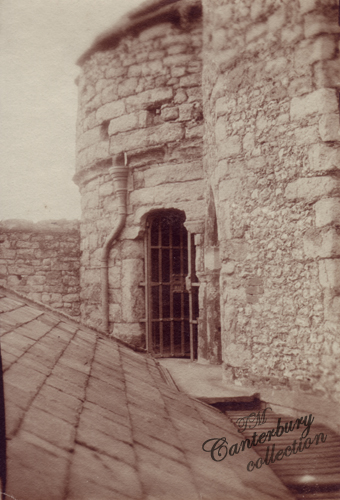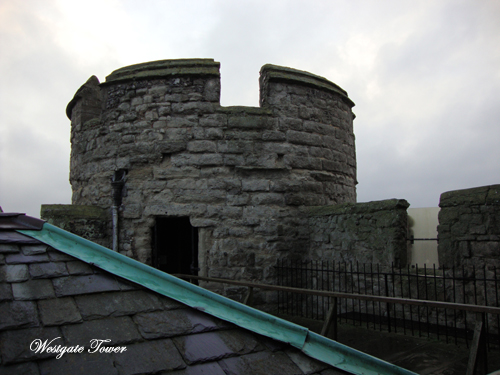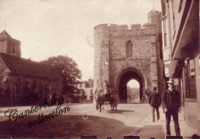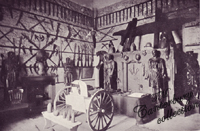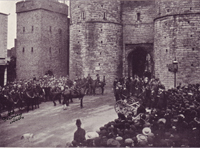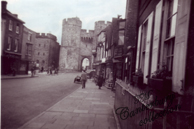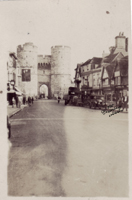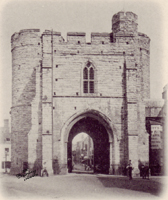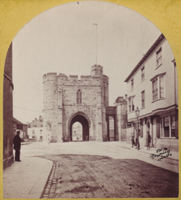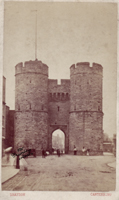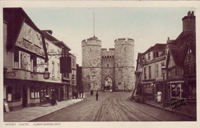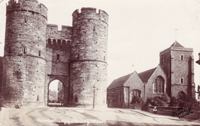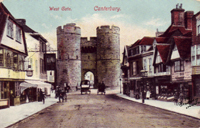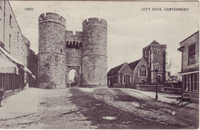
![]()
~ WESTGATE ~
THE WESTGATE
CANTERBURY
The only major gate of the original seven still standing
http://www.canterburywestgatetowers.com/
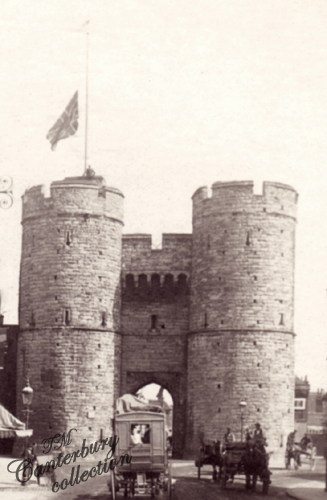
The Westgate...who's future as a historical attraction is still up for debate
From 1543 to 1829 it was used as the city gaol. A debtor was confined here as late as 1847.
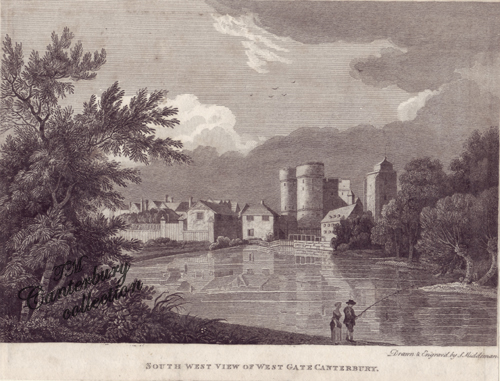
An engraving of the Westgate, Canterbury, south west view. Drawn and engraved by S. Middiman c. 1800
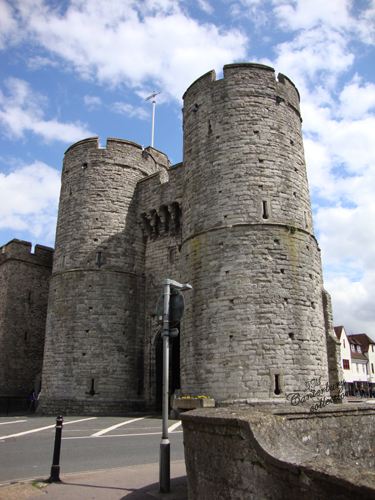
"In 1906, thanks largely to the late Mr. Francis Bennett-Goldney, F.S.A., then Mayor of Canterbury, this interesting and remarkably well preserved relic was restored to public use, the upper part being converted into a Museum (admission 2d., children 1d.). Among other objects of interest may be mentioned the old condemned cell; a series of life-size plaster figures of mediaeval barons, used as models for the bronzes in the House of Lords; a bronze bell dated 1597, and a collection of old arms, implements of torture, constables' staves, etc. Of interest to many are a "boneshaker" cycle and a machine of the type that cyclists of 1886 called "ordinary." Others will be more attracted by a scold's muzzle, with an ingenious contrivance for stilling voluble tongues. On one of the battlements is mounted an old culverin. Visitors should ascend by the newel staircase to the top of the tower for the sake of the fine view of the Cathedral, the surrounding city and the river."
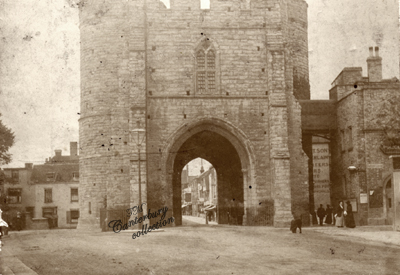
Westgate, Canterbury from a photograph 1897 (in my collection)
"In 1453, Henry VI. granted to the corporation the custody of his gaol at Westgate, which gate from that time at least, if not previously, has been used as a city gaol; considerable additions have been recently made to it, and a house for the gaoler was erected in 1829, in a style corresponding with the character of the original building; airing-yards have lately been formed, and other improvements effected." A Topographical Dictionary of England 1831
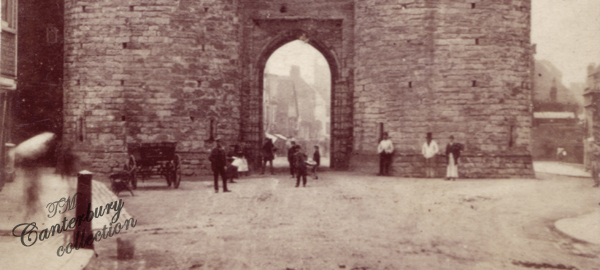
Detail from Brookes Bros. Photographer (late C. M. Drayson) CDV photograph c. 1880's
Richard Berne, of Canterbury, 28th April, 1461. My body to be buried in the aisle before the cross, in the south part of St. Paul's, at Canterbury. To the rebuilding of the bell tower of the monastery of St. Augustine ix l. to be paid as soon as the said work shall be begun; to the prisoners of the Castle of Canterbury and of Westgate vi s. viii d. each; to the Prioress of the Church of St. Sepulchre, towards the works of her Church xiii s. iv d.; to the repair of the highway leading towards Sandwich, by St. Martin's Hill and the Fishpoole x l.; towards the repair of the highway in the Winecheape, between Bircholle's Place and St. James's Hospital x l.; to Joan, my wife, my furniture and my best cart, and my five horses fit to draw it, with all their harness; to the building of the new bell tower of Tenterden vi s. viii d. Richard my son. Proved 7th May 1461, at Canterbury. Testament a Vetusta 1826
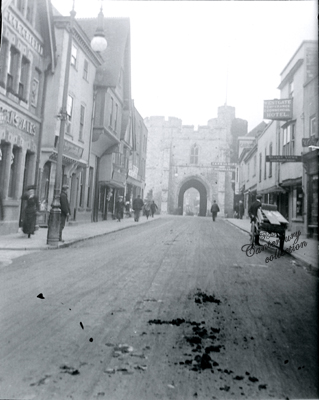
1416 (Feb 5) from the will of Robert Raulyn.....to the prisoners of Westgate 12d. and in the Castle of Canterbury 12d.
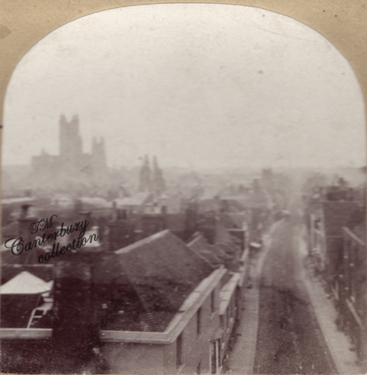
The view from atop Westgate showing the future Barrets building on the left
1479 The house, at the Westgate, is constantly in the hands of the Mayor, for the time being, at the rent of 40s. a year. HT
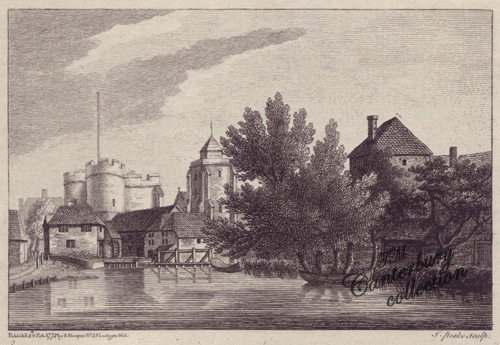
The Westgate, Holy Cross Church, River Stour and Mill c. 1772
The Mill seen in this view, stands on the foundation of one mentioned in Domesday-book, as belonging to the archbishop, but then in the hands of the canons of St. Gregory. It has since returned to the archbishoprick, and continues a parcel of its demesnes."
"This view represents the West Gate of the city of Canterbury, the church of Holy Cross, West Gate, the river Stour, and part of the city wall, with one of it's towers. It was drawn in the year 1749.
The West Gate was built by Archbishop Simon Sudbury, in the time of King Richard the Second, on the site of a former gate, mentioned shortly after the Conquest, by Edmerus, the monk of Canterbury. It now is, and has been ever since its erection, the common goal of this city, as well for debtors as malefactors.
Over the ancient gate, stood a church called the Holy Cross of West Gate, which belonged to the priory of St. Gregory, but being taken down with the gate, the present church, retaining the name, was built in it stead, about the year 1381.
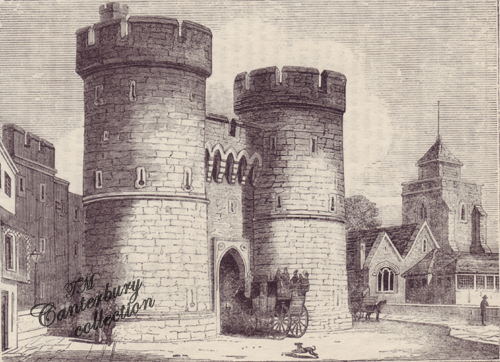
Showing Westgate Without, the entrance to the city, with Holy Cross church above
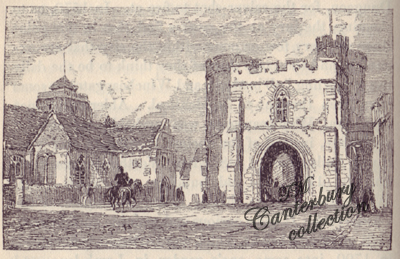
December 15, 1825 - John Ward a Private in the 47th Regt. threw himself from the top of Westgate Prison he was killed on the spot.
The numerous accidents arising from the extreme narrowness of the western entrance into Canterbury, had long been a subject which called loudly for amendment, and it was finally resolved by the trustees of the road, to purchase the buildings on the north and western sides of the towers, and on their site to make foot paths, extending, by means of bridges, across the Stour. This plan was commenced in the early part of the present year, and the houses on the northern side were taken down and rebuilt several feet in the arrear of the former, thereby improving the entrance in appearance, and rendering it completely safe for foot passengers. WG1825
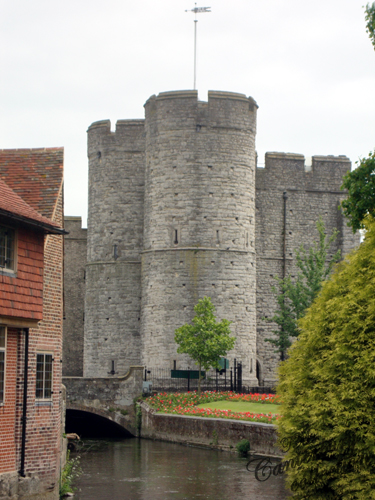
On December 25, 1647, a disturbance having arisen between the townsmen, and one Page, a dissenter, then mayor, on the subject of keeping Christmas-day, and he being fearful of an insurrection, obtained troops from the committee of the county, who, to punish the townsmen, threw down part of the city wall, near St. Mildred's Church, and burned the gates. These were afterwards repaired by Archbishop Juxon, whose arms, with those of the SEE, are on West Gate, St. George's Gate, and Bur Gate.
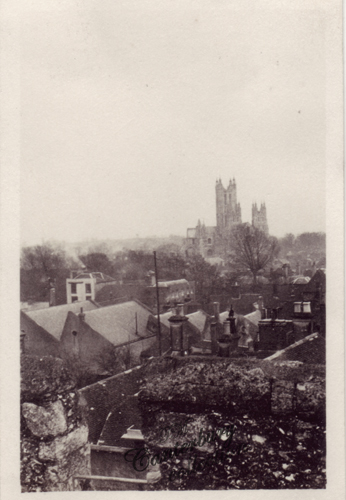 ___
___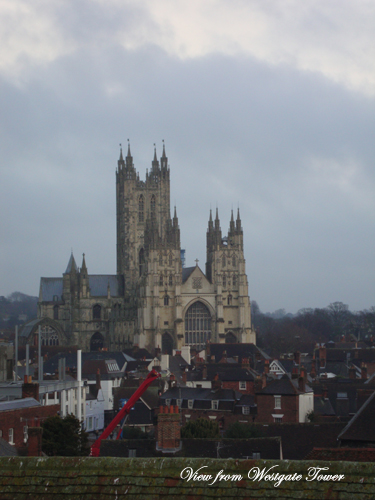
A view of the Cathedral from atop the Westgate c. 1930 and 2010
1775. The city cage is removed from under Westgate, and placed in the new shambles in St. Andrew's. HT
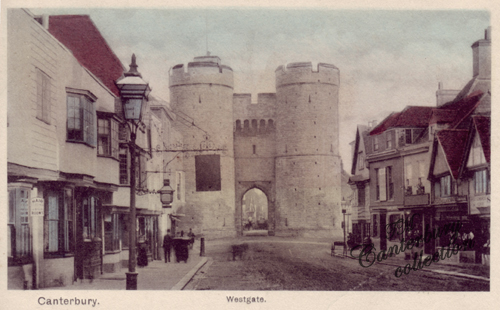
1785. The large wooden doors at Westgate and Saint George's gate are removed away. HT
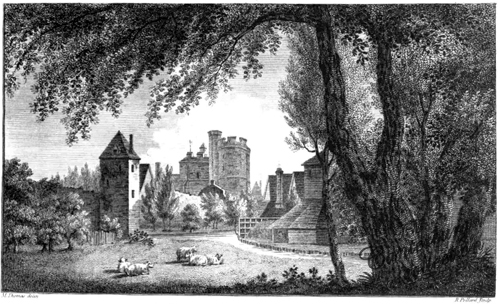
The North View of Westgate from Hasted, showing Sudbury's Tower on the left
1793. The gaol at Westgate, undergoes a very large repair and alteration. The gate itself, Mr. Somner says, was re-edified, in king Richard II.'s days, by archbishop Sudbury, who was called to the see of Canterbury in 1375, and died in 1381. HT
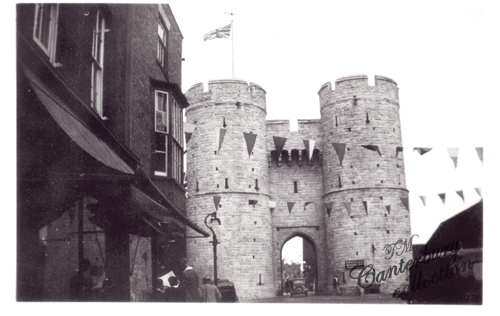
A view of Westgate without from a photo in my collection c. 1935
Death, January 26th, 1794, at Canterbury, Mr. William RUCK, a sheriff's officer for East Kent, one of the serjeants at Mace and keeper of the goal of Westgate in that city. KR
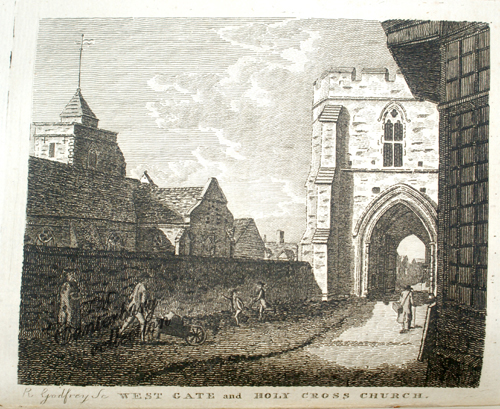
Westgate and Holy Cross Church
Westgate, the only one remaining at the present day, was re-erected in the reign of the second Richard by Archbishop Sudbury. This gate is situated at the west end of the city, and being the road to London, was the largest of the city portals, and presents an imposing appearance, being flanked by two lofty and spacious round towers, erected on the eastern side of the river. It is built of square stones, and embattled, portcullised, and machecollated, and is connected with the western side of the Stour by a bridge erected by Archbishop Sudbury. Over this gate is the city gaol, both for malefactors and debtors, having been so applied ever since the time of its erection. 1838 directory
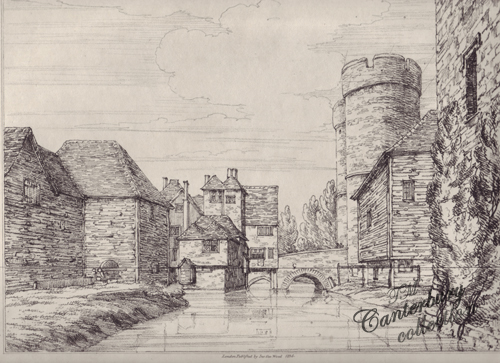
The Westgate 1814, from my collection
In 1794, the large room over the gate of the city prison was divided into three apartments; a square lantern erected upon the platform for giving more light, and other repairs took place amounting to nearly 400l. WG1825
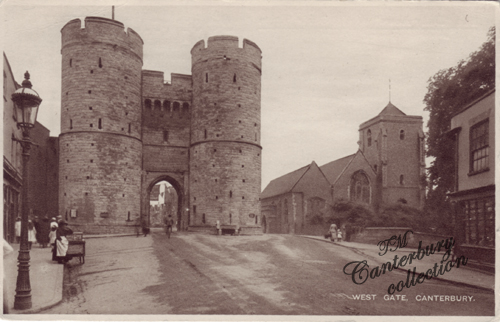
Two Notes from John Knowles addressed "to my loving friend (Sir) Paul Barret, of Chislet, this I pray deliver," requesting his assistance to get him out of Westgate Prison, 2s. Feb. 1644 - Dec. 1645
GM1838, Kentish Books, MSS., Prints and drawings on Sale
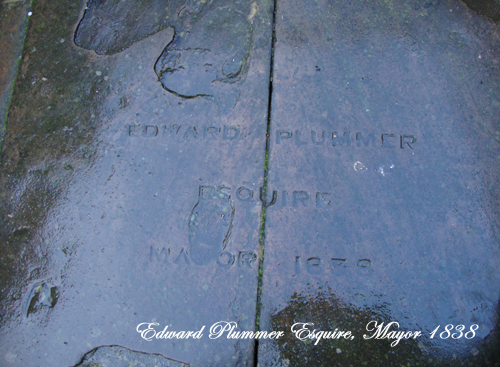
At the top of the Westgate Towers
EDWARD PLUMMER
ESQUIRE
MAYOR 1838
"There were some repairs done to Westgate in 1625 prior to the arrival of Charles I and his queen ..."a mason and his man worked for eleven days on the repair of Westgate."
Canterbury A history of the ancient city written by Charles J. Cox 1905
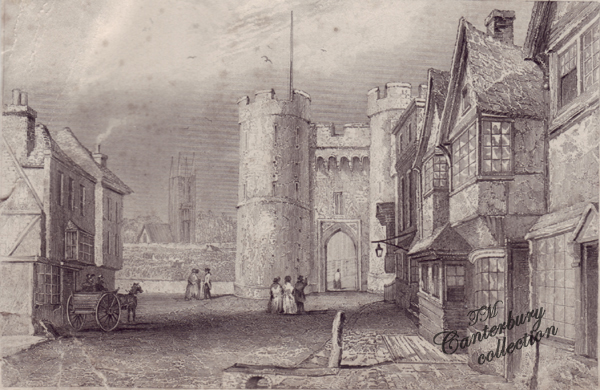
View of Westgate
"Westgate, the next we come to, is the largest and best built of any the city has, and though plain, makes a very handsome appearance, standing between two lofty and spacious round towers, founded in the river at the western corners, embattled, portculised, and machecollated, and a bridge of two arches over the western branch of the Stour at the foot of it. The gate has also the advantage of standing open to a very long and wide street, being on the road to London, both for those who travel by land, and such as go by Whitstable six of seven miles off, and take their passage on board the hoys, which sail every week or oftner, which such heavy and bulky lading as wood come to dear by land-carriage, which on this road is remarkably expensive. This gate is now the city prison, both for debtors and criminals, with a large and high pitched room over the gateway, and others in the towers. The way up is through a grated cage in the gate level with the street, where the prisoners, who are not more closely confined, may discourse with passengers, receive their alms, and warn them (by their distress) to manage their liberty and property to the best advantage, as well as to thank God for whatever share of those blessings he has bestowed on them. Archbishop Sudbury is recorded as builder of this gate, and of the wall called the long wall, which runs northward from it a great way with the river, parallel to the foot of it, till at an angle of each, it turns off round a small meadow to a mill, where it divides again, and one of the branches approaching the wall near a postern, turns eastward as in the plan, and soon receives that channel which entering the city at St. Mildred's makes this west part of Canterbury an island, and ran till very lately under three port-cullised arches of uncommon construction, above which the old wall afforded the only dryshod communication between the east and western parts of the city when the river overflowed its banks at King's-bridge, in High Street; but this well was suffered to run to ruin; the way above it was stopped up some years ago, and in widening the passage over King's-bridge in 1769, somebody found out it would be good economy to demolish those curious arches, as the materials might perhaps save some expense in the new work; the experiment therefore was tried accordingly."WG1777
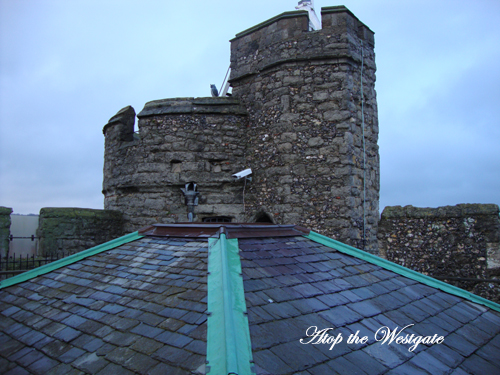
1799. Margaret Hughes, convicted of poisoning her husband, is executed at the front of the gaol at Westgate, and her body is delivered to the surgeons, at the infirmary, to be dissected. HT
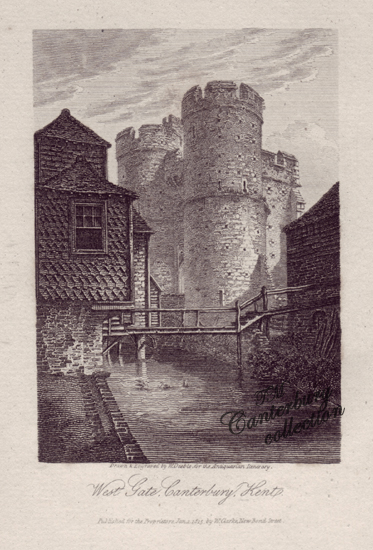
An engraving of West Gate from the Antiquarian Itinerary (single leaf)
"The entrances into Canterbury were formerly by six gates; named West Gate, North Gate, Bur Gate, St. George's Gate, Riding Gate, and Wincheap Gate, the latter having been built in the room of a more ancient gate, styled Worth Gate. The West Gate is the only one remaining, which was erected by archbishop Sudbury, in the reign of Richard the Second; it is a lofty, spacious, and well-built structure of stone, and consists of a centre flanked by round towers. The whole summit is embattled, and the entrance is defended by machicolations, the parts for the portcullis being still perfect. One of the branches of the river Stour flows in front of this Gate, and is crossed by the London road over a bridge of two arches, built likewise at the expense of one of the archbishops. From the time of Henry the Sixth this Gate has been used as the city prison, both for criminals and debtors; and to render it more commodious, various alterations were made in the interior, about the year 1794.
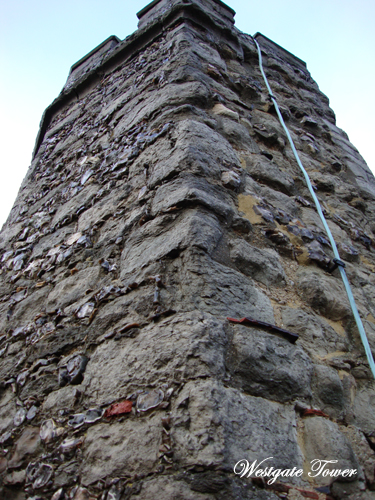
Showing the lovely old stones used in the building of the gate
Simon de Sudbury, the above named worthy prelate, was translated to the see of Canterbury from that of London in the year 1375. He was a man of splendid talents, and much employed in state affairs in the early part of the reign of Richard the Second, by whom he was appointed chancellor of England, in January 1380. On the 14th of June, in the next year, he was barbarously murdered on Tower-hill, by the mob under Wat Tyler, together with sir Robert Hales, prior of the hospital of St. John of Jerusalem. Besides the West Gate, this prelate erected a considerable portion of the wall extending from thence towards the North Gate; he also made considerable alterations in the west transept of the cathedral, to adopt it to the style of architecture at his time in use." AI1815
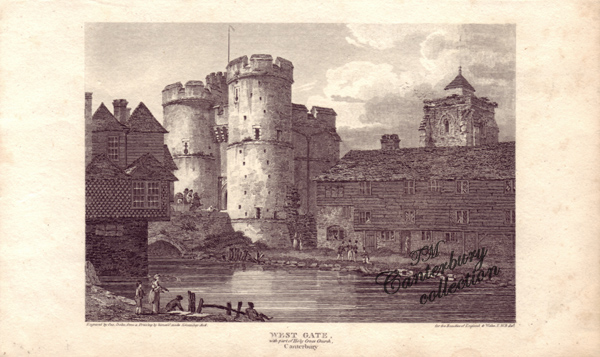
"West Gate with part of Holy Cross Church, Canterbury", c. 1807... the soldier's at the Westgate
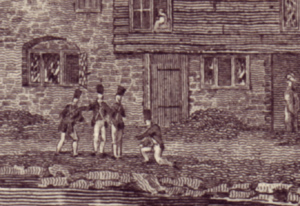
"Jan. 6. Reading in your last Magazine the fates both of Ostenhanger-house and the ancient one at Chislehurst, it reminded me of a letter which I lately received from a gentleman residing in that county, in which, among other intelligence, he writes, "I am sorry to say that the Corporation of Canterbury talk of taking down that fine gate" (the West gate, which is the city prison), "if the jail, which is in a bad state, cannot be repaired; but I hope this is only rumour. The Canterbury Antiquaries are all dead or fast asleep!
I wish it may be only rumour; yet I fear that the motive is the same as in the case of the three curious portcullised arches in the town wall serving as a bridge over the river, which the Rev. Mr. Gostling informs us, in his excellent account of that city, were sacrificed in consequence of "somebody having found out it would be good economy to demolish them, as the materials might save some expense in the new work at King's bridge; the experiment therefore was tried accordingly!
Your zeal for the preservation of our venerable remains of antiquity is evinced by your readiness in giving admission to communications of threatened destruction. May it yet save this noble gate; not hid in an obscure corner, but, as Mr. Gostling observes, "standing open to a very long and wide street," a gate that has been a favourite subject with artists, Mr. Dighton in particular: whose highly-finished South view of it from the river, in water-colours, taken in 1809, is in my possession.
The prevention of occasional stoppages is perhaps the only advantage that would be gained by its removal; but this, independent of the loss of so great an ornament to the city, would be dearly purchased, as, in addition to the heavy expense of taking down so large a structure, the bridge, which must necessarily be widened, would greatly increase the sum. I trust therefore, that the Corporation will pause, before they prosecute their design. G.W.L." GM1824
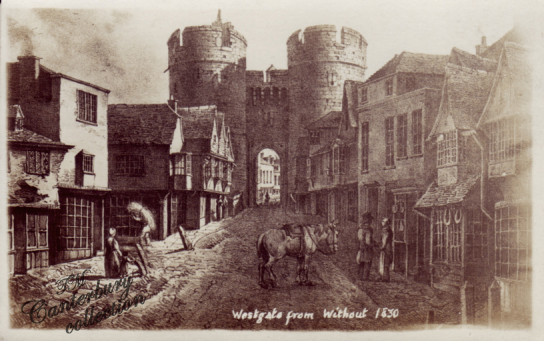
Westgate from without 1830
"There are some chalybeate springs, and one slightly sulfurous, in the extensive nursery-grounds of Mr. W. Masters, near the West gate.
....and of the six gates that formed the principal entrances, only the western, forming the entrance from the London road, is now standing. It is a handsome embattled structure, erected about the year 1380, by Archbishop Sudbury, who also rebuilt a considerable portion of the city wall; and consists of a centre flanked by two round towers, having their foundations in the bed of the western branch of the Stour, over which is a stone bridge of two arches, that has been widened for the accommodation of carriages and foot passengers, an approach having been cut through the city walls for each.
In 1453, Henry VI. granted to the corporation the custody of his gaol at Westgate, which gate, from that time at least, if not previously, has been used as a city gaol; considerable additions have been made to it, and a house for the gaoler was erected in 1829, in a style corresponding with the character of the original building." 1848
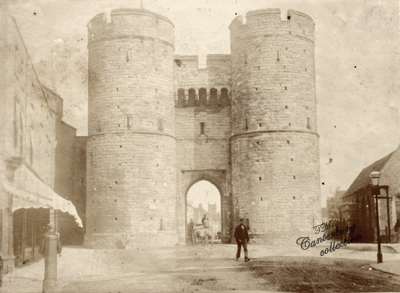
"THE WESTGATE, without" from a photograph in my collection 1897
"The goal, or common prison, was removed afterwards to Westgate, which has been rebuilt by Archbishop Sudbury, A.D. 1375, and chiefly at his own charges. Westgate Gaol was enlarged A.D. 1637; and has in our own times received considerable additions. A messuage and garden were purchased next Westgate, A.D. 1637, for the gaol keeper's house, for 70l."
The city gaol, A.D. March, 1800, contained one prisoner, a debtor.
August, 1806, 0 debtors, one felon.
July, 1810, 0 debtors, six felons.
COT1879
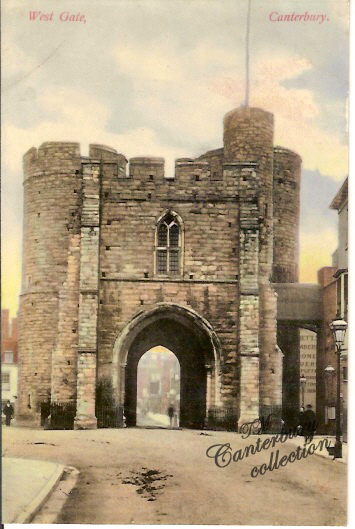 __
__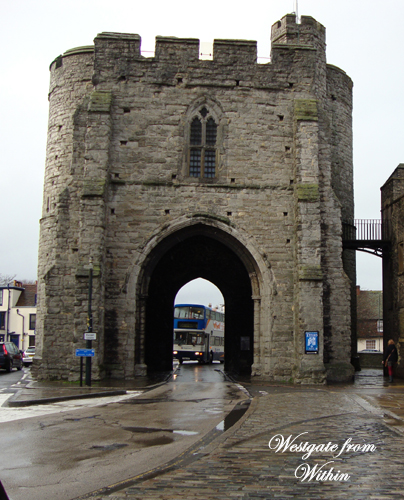
Westgate from within
"The Westgate, the only one of the city gates now remaining, is a structure of squared stone with two fine round towers and a battlemented parapet. From 1543 until 1829 the Westgate was used as the city goal, and in the lofty guard chamber over the archway the condemned cell may still be seen, together with the gallows. In 1906 this building was opened to the public and the upper part converted into a branch of the Royal Museum."
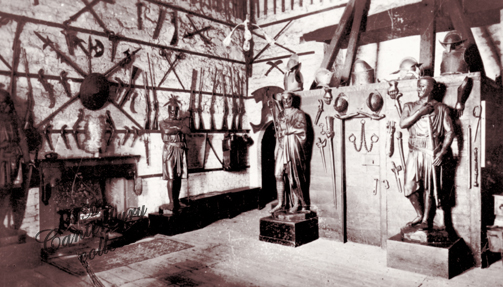
"THE CONDEMNED CELL" in the Westgate, an old postcard from my collection
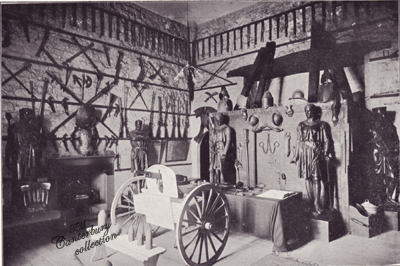
Showing the machine gun in the Westgate that had been with the 33rd Company of the Imperial Yeomany in the Boer War. It was presented by Col. Lord Harris on May 23, 1906.
1726 - Mr. Comberford, Keeper of Westgate Gaol
"Report of the committee: With an appendix, Volumes 1-5" 1820
Canterbury - Westgate Gaol, number of prisoners - 20, number of classes or departments - 1
Canterbury Bridewell - number of prisoners - 12, number of classes or departments - 6 cells
St. Augustine's Gaol - number of prisoners - 41
April 13, 1833, The Court Journal - Sir W. Courtenay, whose eccentricities have gained him considerable popularity at Canterbury, was removed from Westgate gaol in that city, a few days since, by Habeas Corpus, to the King's Bench, his friends having obtained an order from the Court. A large concourse of people assembled to witness his departure, whom he addressed from the roof of the coach, amid load and cordial greetings.
Prisoners in Custody on November 27, 1837
Gaol and House of Correction at St. Augustine's
Felony - Males 13, Females 1 (J. Bone, Keeper), November 29, 1837
For trial at Sessions - Westgate Gaol, Canterbury
Priscilla Saunders age 52, wife of Thomas Saunders - When Committed - November 15, 1837. Offence - stealing from the person of Henry Callagham, Mariner. November 29, 1837. William Young, Keeper
Parliamentary Papers - 1846
East Kent - St. Augustine's Gaol and House of Correction, Westgate Gaol, and the House of Correction, St. Margarets, number of persons - 83 (Males 68, Females 15)
"A.D. 1802, Mr. Nield, acting justice for Kent, &c., officially visited "Canterbury gaol." "The place," he states, "was most offensive; no bedding was allowed in some of the cells, but an old rag of a rug, and the prisoners, felons and debtors, male and female were allowed promiscuously to consort together during the day time." COT
A view atop Westgate c. 1905 (from my collection on the left), and a partial view now 2010, the cell is still there see below
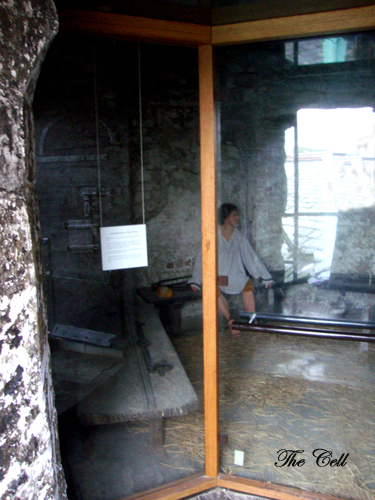
"A.D. 1707, a practice obtained of certain
prisoners from Westgate being allowed
to be at large. This was afterwards prohibited except by special licence
from the Mayor."
COT1879
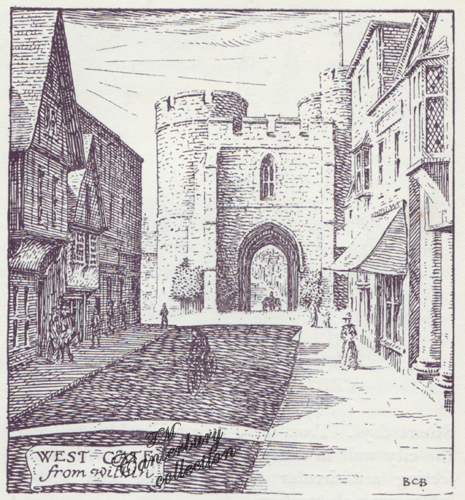 _____
_____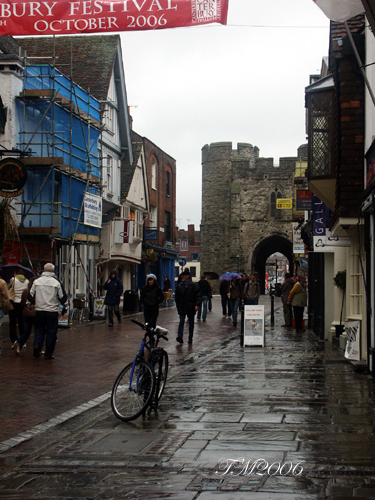
Drawing JCC c. 1905 & my recent photo
"Westgate was built by archbishop Sudbury, in king Richard II's reign, in the room of the ancient one, which was become ruinous, over which there was built a church. This gate, situated at the west end of the city, through which the high road passes towards London, is the largest and best built of any the city has, making a very handsome appearance, standing between two lofty and spacious round towers, erected in the river, on the western side of it. It is built of square stone, and is embattled, portcullised, and machecollated, having a bridge of two arches, belonging to the archbishop, over the western branch of the Stour, adjoining to it. Over this gate is the common goal or prison, both for malefactors and debtors within the jurisdiction of this city and county of it, and has been so from the time of the building of the present gate, but certainly so from the 31st of king Henry VI. for then, as king Edward IV. in his charter, recites, he granted to the city by his charter, the keeping of his goal, at the Westgate of his city of Canterbury, for prisoners imprisoned within the city and suburbs, for whatever crime or cause they should be taken, to be detained in it by themselves or their officers (*see Battely's Somner pg. 14). The gates themselves of this, as well as of the other two gates left standing, have been lately taken away by the city, as supposed to be of no further use. The arms of archbishop Juxon, with those of the see of Canterbury, were carved on these gates here, as well on those of St. George's and Burgate; they having been all new made and set up by that archbishop at the Restoration, in the room of those destroyed and burnt by the Puritans, in 1648."
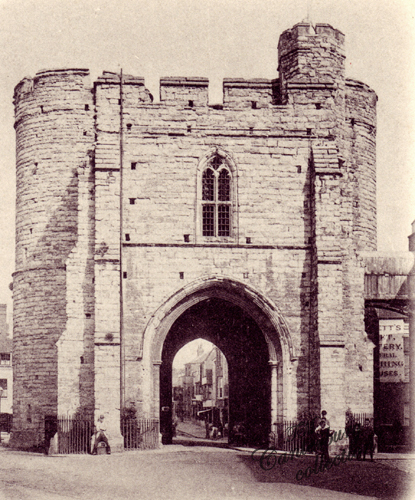 ____
____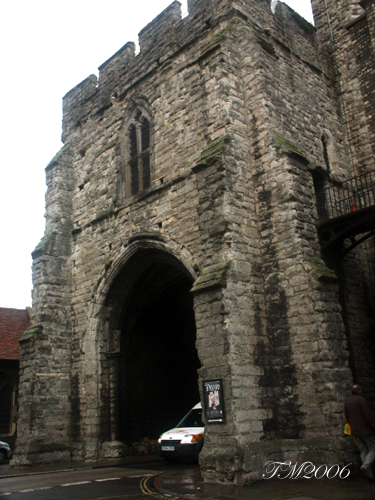
"The Westgate Within" from an old postcard in my collection, and my recent photograph
"At the top of the tower is a fine bronze bell bearing the date 1597, saved from the destroyed Church of St. Michael, which formerly stood just inside the City Wall close to the Burgate." from a Pilgrim's Guide
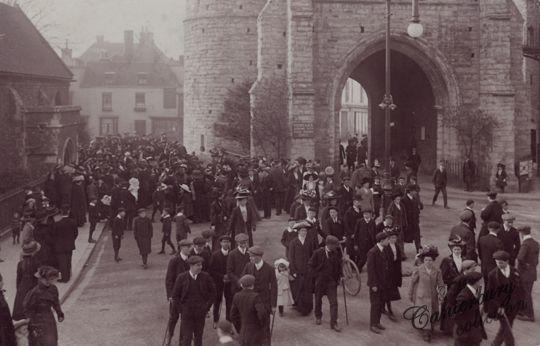
My postcard showing the Westgate Within, and Holy Cross Church on the left c. Fall of 1910 (no leaves on the trees)
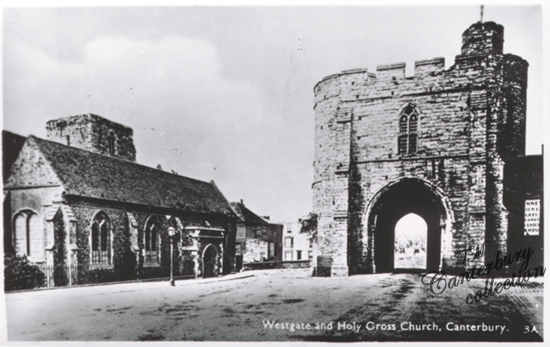
1840's
Westgate Goal
George & Mary Ann STONE
Thomas Oliver
John Deakney
Israel MacClean
William TERRY
Thomas Standven
George Lee
George Keene
Henry Silk
Eliza West
William Evans
William Cullen
Tayton Read
John Withers Powell
Elizabeth Perrow
1858 - City Goal, Westgate
George STONE, Governor
Rev. Charles BEWSHER, Chaplain
Thomas ANDREWS, Esq., Surgeon
Mary Ann STONE, Matron
|
Westgate within |
Showing the machine gun in the Westgate that had been with the 33rd Company of the Imperial Yeomany in the Boer War. It was presented by Col. Lord Harris on May 23, 1906.
|
It was presented by Col. Lord Harris on May 23, 1906. HB Collis |
Photo 1952 |
|
Photograph
|
H.J. Goulden Postcard
|
Stereoview, Westgate within |
Drayson, CDV |
|
Westgate without |
Postcard, Westgate & Holy Cross |
Westgate without |
Postcard, Westgate & Holy Cross |
|
Stereoview, Westgate without |
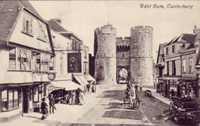 |
|
The very sad news of the death of Charles Lambie who revived the Westgate for future historians.
